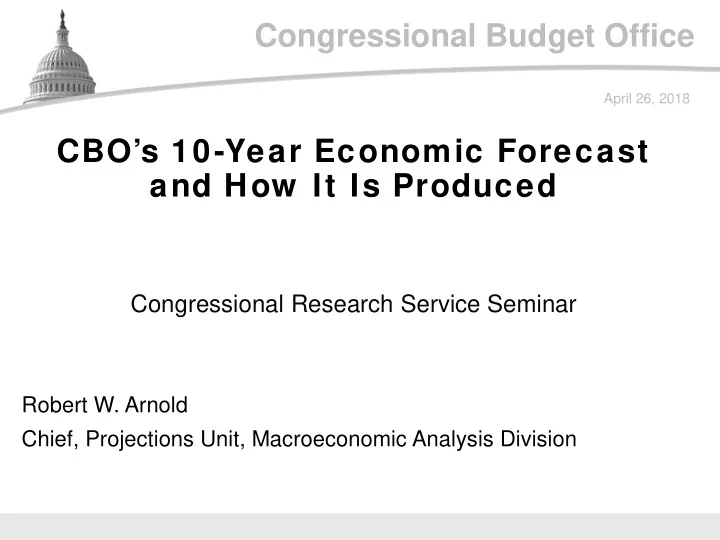

Congressional Budget Office April 26, 2018 CBO’s 10-Year Economic Forecast and How It Is Produced Congressional Research Service Seminar Robert W. Arnold Chief, Projections Unit, Macroeconomic Analysis Division
CBO CBO’s Economic Forecast Process Step 1: Background Analysis Develop preliminary forecast for exogenous variables (e.g., oil prices) Review recent data Step 2: Preliminary Forecast Use macroeconometric model to develop preliminary forecast Incorporate preliminary federal tax and spending projections Step 3: Internal and External Review Obtain input from CBO’s senior staff and other divisions within the agency Obtain feedback from CBO’s Panel of Economic Advisers and staff of Congressional budget committees Step 4: Final Forecast Incorporate feedback and latest data to produce final forecast Transmit to CBO’s budget and tax divisions to develop budget projections 1
CBO CBO’s Forecasting Models CBO’s Labor Force Participation Rate Model (Unemployment gap) (Labor force participation rate) CBO’s Macroeconometric Model Exogenous Variables • Population Aggregate Demand Other Variables • Energy prices • Consumer spending • Inflation CBO’s Budget • Foreign growth • Business investment • Interest rates Projections • Residential investment • Labor market variables • Federal outlays Policy Variables • Government spending - Unemployment • Federal revenues • Labor supply elasticities • Net exports - Employment • Marginal tax rates - Wages & compensation • Other fiscal policies Aggregate Supply • Incomes • Potential output (Investment, potential labor force, (Potential output, hours, productivity, and other variables) and other variables) CBO’s Forecast Growth Model 2
CBO CBO’s Current Economic Forecast 3
CBO Grow th of Real GDP and Real Potential GDP Real potential GDP is CBO’s estimate of the economy’s maximum sustainable output, adjusted to remove the effects of inflation. 4
CBO Output Gap The output gap is the difference between the level of GDP and the level of potential GDP. 5
CBO Determinants of the Grow th of Real Potential GDP Potential labor force productivity is the ratio of real potential GDP to the potential labor force, which is CBO’s estimate of the size of the labor force arising from all sources except fluctuations in the overall demand for goods and services. 6
CBO Unemployment Rate The unemployment rate is the number of jobless people who are available for and seeking work, expressed as a percentage of the labor force. The natural unemployment rate is CBO’s estimate of the rate of unemployment arising from all sources except fluctuations in the overall demand for goods and services. 7
CBO Labor Force Participation Rate The labor force participation rate is the percentage of people in the civilian noninstitutionalized population who are at least 16 years old and either working or seeking work. The potential labor force participation rate is the rate that CBO estimates to arise from all sources except fluctuations in the overall demand for goods and services 8
CBO Consumer Price Inflation Values are shown for changes in the price index for personal consumption expenditures. 9
CBO Interest Rates 10
CBO Effects of the 2017 Tax Act 11
CBO Macroeconomic Effects of the Tax Act Effects on Aggregate Supply : Increased business fixed investment Increased labor supply Decreased residential investment Effects on Aggregate Demand : Increased consumption Decreased net exports 12
CBO Effects on Real GDP and Real Potential GDP 13
CBO Effects on the Output Gap 14
CBO Effects on Consumer Prices Values shown are effects on the price index for personal consumption expenditures. 15
CBO Effects on Interest Rates 16
CBO Effects on Business Fixed Investment Business fixed investment is businesses’ purchases of equipment, nonresidential structures, and intellectual property products. The changes in incentives consist of changes in the user cost of capital, which is the gross pretax return on investment that provides the required return to investors after covering taxes and depreciation, and changes in the benefits of locating business establishments in the United States. Changes in economic activity consist of changes in demand for goods and services and changes in the supply of labor. Crowding out occurs when larger federal deficits reduce the resources available for private investment. 17
CBO Effects on Residential Investment 18
CBO Related Publications Congressional Budget Office, The Budget and Economic Outlook: 2018 to 2028 (April 2018), www.cbo.gov/publication/53651. Robert W. Arnold, How CBO Produces Its 10-Year Economic Forecast , Working Paper 2018-02 (Congressional Budget Office, February 2018), www.cbo.gov/publication/53537. 19
Recommend
More recommend